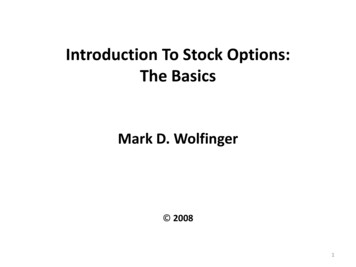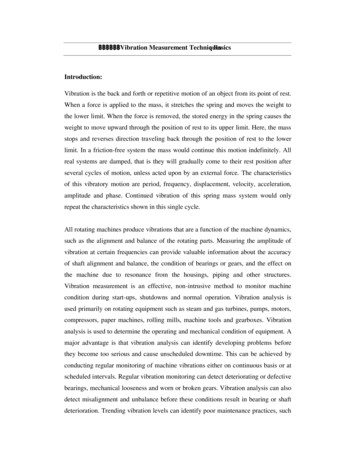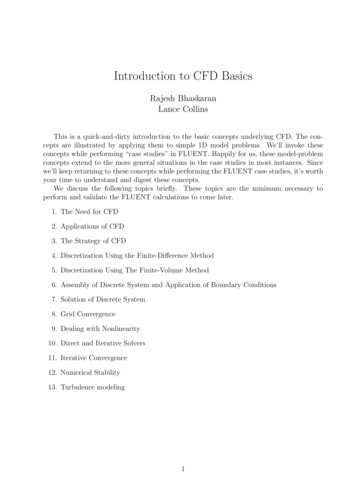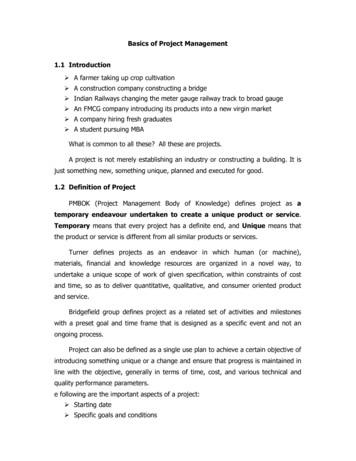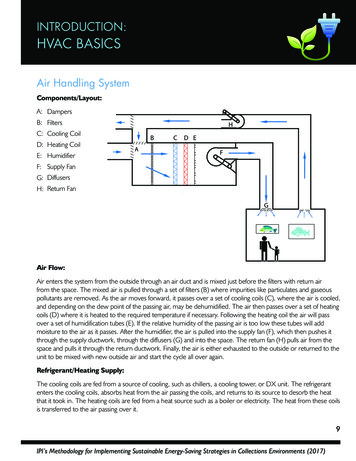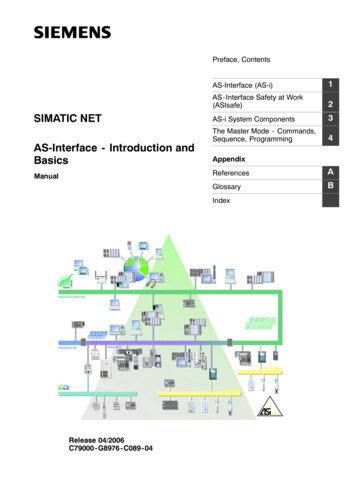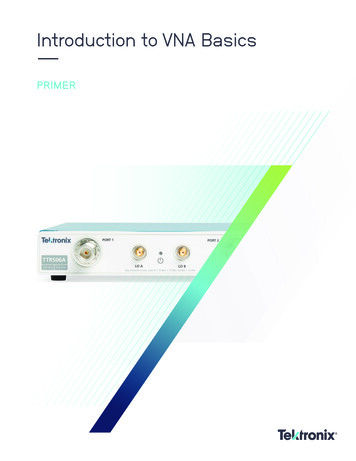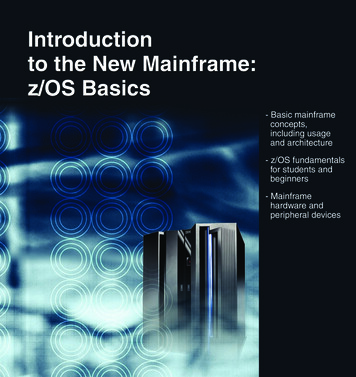
Transcription
WHITE PAPERAn Introduction to the Basics of Video Conferencing
WHITE PAPER An Introduction to the Basics of Video ConferencingIntroductionIn the next few years we shall see explosive growth in the useof video conferencing as a fundamental tool for businessesto enhance communication and collaboration betweenemployees, partners and customers. The technology hasdeveloped considerably from early adopters to its currentform of mass market roll-out. It’s anticipated that nearlyhalf of information workers will have some type of personalvideo solution in 2016, up from just 15% today 1. With videoconferencing becoming a core component of IT infrastructurethat enables communication and collaboration, businesses willbe looking to providers of telephony, business applications andnetwork infrastructure services to include this capability as partof their offering.This report will examine the basic components of thetechnology, considerations for deploying video conferencingsolutions, and will introduce the Polycom RealPresence Platform to readers.What is video conferencing and how does it work?To set the foundations for future elaboration, at the simplestlevel, a video conference is an online meeting (or a meetingover distance) that takes place between two parties, whereeach participant can see an image of the other, and whereboth parties are able to speak and listen to the otherparticipants in real time. The components necessary tomake this happen include: A microphone, webcam and speakers A display A software program that captures the voice stream from themicrophone, encodes it, transmits to the other participant,and simultaneously decodes the digital voice stream beingreceived from the remote participant in the video conference(most commonly referred to as a “Codec”). A software program that bridges both parties togetheracross a digital connection, managing the exchange ofvoice and video between participants. At either end of theconnection, the video and voice traffic is combined anddelivered to each participant in the form of a real-time videoimage and audio stream. An optional management tool for the scheduling of videoconferencing sessionsAt a slightly more advanced level, it is also possible to providethe ability to share content from a device during a video call.The quality and type of content that can be shared depends onthe rate of data exchange during the call.Terminology used by video conferencing users to describe theprocess of dialling into and participating in a virtual meeting isknown as “joining a bridge.” Different virtual meeting rooms areassigned unique “bridge numbers,” and users join a video callby “dialling a bridge number.”Point-to-point video conferencingVideo-enabled meetings happen in two distinct ways: eitherpoint-to-point or with multi-point. In point-to-point, the simplestscenario is where one person or group is connected to another.The physical components (i.e. microphone and camera) thatenable the meeting to take place are often integrated in todesktop computing solutions like a laptop or tablet, or can becombined into dedicated, room-based hardware solutions.An example of point-to-point video conferencing.1. Forrester—Preparing for Uneven Corporate Adoption of Video Communications, May 9, 20112
WHITE PAPER An Introduction to the Basics of Video ConferencingA use-case scenario of multi-point video conferencing.Where desktop solutions tend to be used by individuals,room-based solutions utilize dedicated video conferencingtechnology where groups of people can be seen, heard andcan naturally participate in the meeting.Multi-point video conferencingIn multi-point video calls, three or more locations areconnected together, where all participants can see and heareach other, as well as see any content being shared duringthe meeting.In this scenario, digital information streams of voice, videoand content are processed by a central, independent softwareprogram. Combining the individual participant’s video andvoice traffic, the program re-sends a collective data streamback to meeting participants in the form of real-time audioand video imagery.Individuals can participate in a meeting in an “audio only”mode, or combine audio with video images of the meetingon screen. Depending upon the technical capability ofthe video conferencing system being used, images seenby participants are either classified as “active speaker” or“continuous presence.”In “active speaker” mode, the screen only provides an imageof the person that is speaking at any point in time. In moreadvanced solutions with “continuous presence” mode, thebridge divides the image on the screen into a number ofdifferent areas. The person speaking at any point in time ispresented in a large central area, and other meetingparticipants are shown displayed around the central image.The “continuous presence” mode thus allows meetingparticipants to view and interact with all meeting participantsin a ‘virtual meeting room.’The software program which creates the “virtual meeting room”and the digital processing hardware on which it resides, is oftencalled a video bridge, or “bridge”, for short. Another term for abridge which is often used is a video conferencing “multi-pointcontrol unit” or “MCU.”Whereas point-to-point video conferencing is relatively simple,the creation and management of multi-point video conferencescan be complex. An MCU must be able to create, controland facilitate multiple simultaneous live video conferencingmeetings. A further complexity is added when differentlocations may connect to the meeting over digital or analoguestreams at different speeds, with different data transport andsignalling protocols employed to facilitate the communication.To link these users into a common, virtual meeting, the MCUmust therefore be able to understand and translate betweenseveral different protocols (i.e. H.264 for communication overIP, and H.263 for ISDN). The MCU will also allow those joiningthe video bridge to do so at the highest speed and the bestpossible quality that their individual system can support.Although there are two separate processes taking place here,this is often jointly referred to as “transcoding.”It is important to note that not all bridges provide suchtranscoding capability, and failure to do this can seriouslyimpact the quality and experience of video calls. Whentranscoding is not provided and users dial into a bridge3
WHITE PAPER An Introduction to the Basics of Video Conferencingover a range of different connection speeds, it is possible thatthe bridge may only be able to support the video meetingby establishing the connections at the lowest commondenominator. To illustrate the negative effect of this, considera meeting that takes place with most users joining the bridgefrom the high-speed corporate network, but where one or twoindividuals dial into the meeting from home on low-bandwidthDSL or ISDN. In this case the experience of the many corporateusers is downgraded to the lowest common denominator ofthe home-users, potentially making the video call ineffective.Where effective transcoding is supported by the MCU, thoseon the corporate network will continue to enjoy HD videoquality, while remote users receive quality commensurate withtheir connection speeds.In summary, when an MCU is designed well, integrating easilywith multiple vendors and allowing users to call in at the datarate and resolution they want or need to—the result is an easy,seamless experience for all users, allowing people to focus onthe meeting, not the technology.The language of video conferencingAs video conferencing technology has evolved, two mainprotocols have emerged to provide the signalling controlfor the establishment, control and termination of videoconferencing calls: SIP (Session Initiation Protocol) and H.323.For the encoding and decoding of visual information, theindustry is moving towards the industry standard known asH.264, which was developed to provide high-quality video atlower bandwidth over a wide range of networks and systems.An extension to the H.264 protocol is Scalable Video Coding(SVC), which is established to facilitate the enablement of videoconferencing on a wider range of devices, such as tablets andmobile phones.Bridging architecture and functionalityAs described above, the combination of software and thehardware that creates the virtual meeting rooms is calleda “video bridge.” Virtual meeting rooms are identified bytheir “bridge numbers.” With multiple calls taking placesimultaneously, software analyses all the different datastreams coming into the bridge processors, and assignsdata streams accordingly.At the simplest level, the processing workload for bridges isdependent upon four factors: The number of locations that dial into each bridge The number of conferencing calls that each bridge musthandle simultaneously4 The amount of data that is being received on each digitalstream: higher resolutions of images and sound (i.e. HighDefinition) generate more data that needs to be processed The degree of transcoding that the bridge must performwhile handling calls being received at different connectionspeeds and utilizing different protocolsAs the workload increases, each bridge must process moredata. Performance can therefore be improved by increasingthe number of Digital Signalling Processors (DSPs) utilized todecode and encode the digital streams entering and leavingMCUs. If the bridging function becomes overloaded, videoand voice information may be lost, causing latency to beintroduced into calls, both of which can degrade the videomeeting experience.Extra processing resource can be provided for the bridgingfunction by either utilizing a more powerful bridge (witha greater number of DSPs) or through a virtual softwareapproach, where the software that controls the signallingfunction can operate independently of the physical hardware.A conference call with an assigned conference number doesnot have to take place, or be processed by a dedicated pieceof hardware. The call can be “virtualized”, and assigned towhatever physical bridge has the correct resource or capacityto handle the call. A virtualization manager oversees whichphysical bridge has the capacity, and assigns incomingcalls accordingly.In extreme, but rare circumstances, the virtualization managermay assign resources for a call across several differentphysical bridges that work in tandem together. Known as“auto-cascading”, the resources within the physical bridge canbe instructed by the software to operate in a “parent-child”arrangement, with one bridge “owning” the conference call,and the others sharing the workload.In the continuous presence mode of presentation, the bridgewill automatically provide the screen templates in which theviewers will see the other meeting participants. The bridgecan also provide some administrative functionality for thecall, such as assigning passwords to enter each meeting, andproviding Interactive Voice Response (IVR) functionality, wherecall participants can be greeted and instructed by customizedvoice greetings.Although most participants will actively dial into a videoconferencing meeting, the bridge can be programmedto automatically dial out to participating locations andautomatically connect them in to a meeting. For example,the bridge could automatically wake up the cameras in
WHITE PAPER An Introduction to the Basics of Video Conferencingremote meeting rooms, and link those meeting rooms into aprescheduled call. Participants of such a meeting would simplyhave to walk into the video room at the correct time, and jointhe meeting.Video call management and protocol conversionIn order to build an architecture that scales, the softwareplatform must be able to provide call signalling functionality,and dynamically manage the set-up and maintenance of a largenumber of video calls. The software architecture has to becapable of reconfiguring itself and its resources in real-time, sothat these resources are used to their best ability. In addition,the software architecture has to understand the bandwidthrequirements of each call being placed, the policy that isassociated with each call (the prioritization and importance ofa call), and where the participants of a call are geographicallylocated. By understanding this, the software platform can utilizelocal resources instead of redirecting data streams and callsignalling to resources that are far away, an approach whichwould eat up large amounts of bandwidth on WAN links thatare very costly.The software platform should also be able to instantly detectany failure of hardware resources or loss of communicationacross infrastructure links, so that it can re-direct traffic andre-establish calls utilizing alternative resources, without overlyimpacting video calls or their quality.When systems on different customer premises try to join thesame video call using devices which run different protocols(i.e. H.323, RTV or SIP), the video conferencing platform mustfirst perform protocol conversion to a common language sothe infrastructure can understand and process informationcorrectly. In other words, the software platform should provideintrinsic gateway functionality between devices that talkdifferent languages.The Polycom RealPresence DMA sits in front of the bridges,and interfaces between the outside world and the bridgingresources. This optimizes how incoming video calls arehandled by virtual resources at its disposal. The PolycomRealPresence DMA can apply business rules that help it placeincoming meetings on bridges that make the most sense, eitherfor capacity, geography, or other priority rules.Let us consider three examples of this approach and see how it simplifies the process.Example ACustomer A in California wants to meet with Customer B in New York, Customer C in London andCustomer D in Paris. The Customer has a video bridge in Denver and a video bridge in Paris anda virtualization manager o
bridge which is often used is a video conferencing “multi-point control unit” or “MCU.” Whereas point-to-point video conferencing is relatively simple, the creation and management of multi-point video conferences can be complex. An MCU must be able to create, control and facilitate multiple simultaneous live video conferencing meetings. A further complexity is added when different
